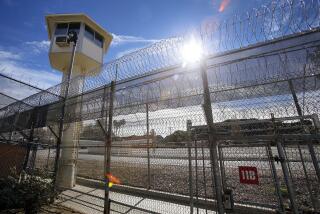High Security : Subduing Rioting Inmates at a County Jail
Through May 9 this year at the Peter J. Pitchess Honor Rancho in Castaic there have been 52 “disturbances”--which is the official prison term for inmate fights. Although some have been between only two inmates, others have turned into brawls involving as many as 1,000 in numerous dormitories, according to Commander Robert Spierer, who oversees operations at the compound housing 10,000 inmates in five facilities.
A few of the fights are strictly personal, arising out of arguments over the use of the telephone or changing the channel on the television. But the vast majority of the serious fights have been racially based, usually pitting Latinos against African Americans, according to the Los Angeles County Sheriff’s Department, which oversees security at Pitchess.
Housing inmates in dormitories and barracks, as opposed to individual cells, has contributed to the seriousness of the fights because outbreaks are more difficult to control in open areas. And Spierer said that fights often come in series, much like an earthquake is followed by aftershocks. “A big disturbance is usually followed by a bunch of little disturbances,” he said.
Whether a brawl involves two or 1,000 inmates, the policy in quelling the disturbance is to use the least amount of force necessary, Spierer said. The only deputies armed with lethal weapons are those in guard towers.
When a Disturbance Breaks Out
Officials initiate a sequence of increasingly forceful measures:
1. Verbal Order: “Typically, a deputy will give a verbal order to those involved to return to their bunks,” Spierer said. “In most cases, they comply.”
2. Pepper Spray: If the order is ignored, the next step would be to use Oleoresin Capsicum, better known as pepper spray. The spray causes a burning sensation in the eyes, but does not cause permanent damage.
3. Emergency Response Team: If the pepper spray is ineffective or its use would put a deputy in a dangerous situation, a supervisor is notified and an 11-member emergency response team is activated.
* The deputies equip themselves with face shields, protective vests and batons.
* One deputy is armed with a .37-millimeter ARWEN gun that shoots a 3-ounce, 2- to 3-inch plastic projectile that delivers a blow to the chest. “It will cause a bruise and knock down the individual, but it is less likely to cause any permanent damage,” Spierer said.
* Stinger cartridges: Another deputy is armed with a .37-millimeter launcher that shoots “stinger” cartridges. There are two types of cartridges. One is 5 inches long and contains 140 rubber pellets, the other is 8 inches long and contains 220 pellets.
- The pellets cause a “stinging” feeling on impact.
- The stinger cartridges create a controlled pattern of pellet dispersion.
* Stinger grenades: For a wider dispersion of the pellets, deputies also have stinger grenades. The grenades are rubber balls containing an explosive charge which disperses 180 pellets in a circular 50-foot radius.
4. Lockdown: When a disturbances breaks out, a “lockdown” is immediately implemented to stop all inmate movement, Spierer said. Instead of the individual cells commonly associated with a jail, the compound has dormitories and barracks housing from 50 to 140 inmates each.
So far this year, 365 inmates have been injured as a result of the disturbances, but only about 10% required hospitalization. Four deputies have been injured, none seriously.
COMPARING 1994 WITH 1993
1994 1993 (Through May 9) (for whole year) Inmates incarcerated: 10,000 10,000 Number of disturbances: 52 57 Inmates involved in disturbances: 3,800 5,500 Inmates injured: 365 443 Deputies injured: 4 16 Deaths (deputies or 0 0 inmates) from injuries:
Source: Los Angeles County Sheriff’s Dept.
More to Read
Sign up for Essential California
The most important California stories and recommendations in your inbox every morning.
You may occasionally receive promotional content from the Los Angeles Times.










